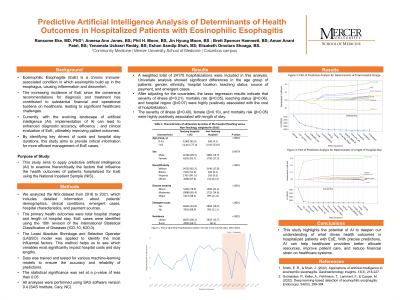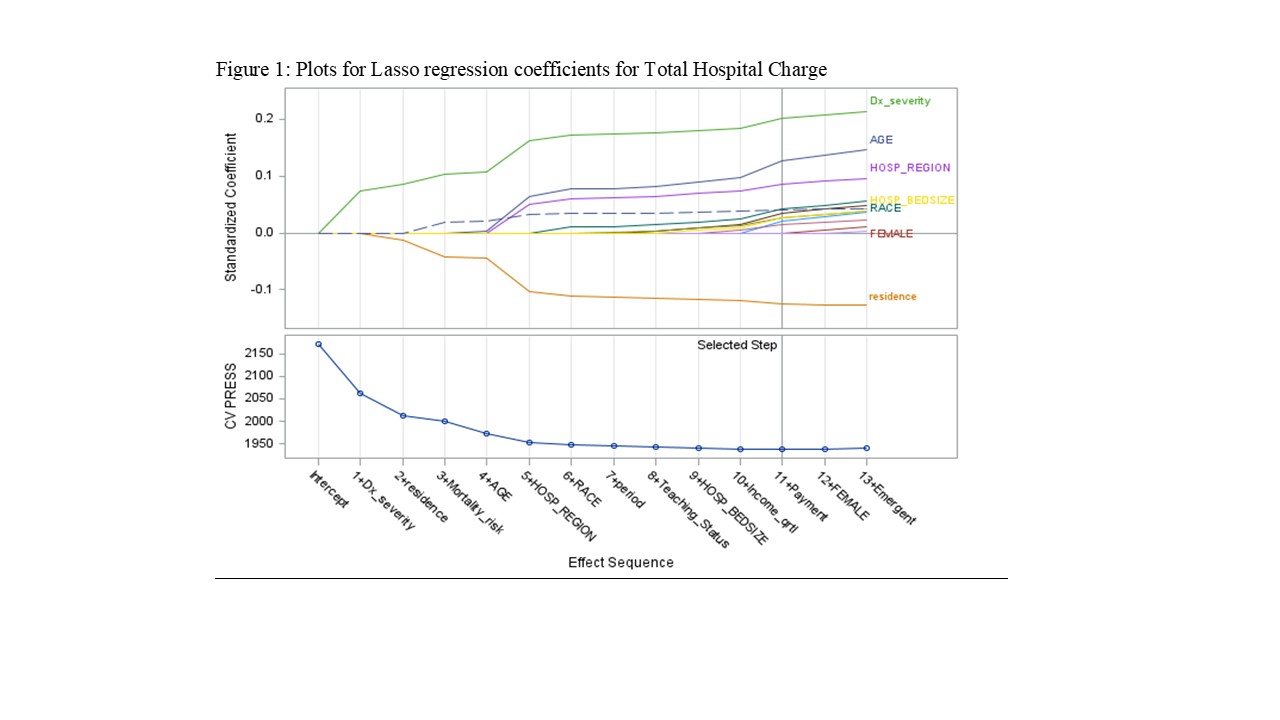Sunday Poster Session
Category: Esophagus
P0478 - Predictive Artificial Intelligence Analysis of Determinants of Health Outcomes in Hospitalized Patients with Eosinophilic Esophagitis
Sunday, October 27, 2024
3:30 PM - 7:00 PM ET
Location: Exhibit Hall E

Has Audio
- RE
Ransome Eke, MD, PhD
Mercer University School of Medicine
Columbus, GA
Presenting Author(s)
Ransome Eke, MD, PhD, Jin Moon, BSc, Phil Moon, BSc, Brett Hammett, BSc, Aman Patel, BSc, Yenamala Reddy, BSc, Eshan Shah, BSc, Elizabeth Shoaga, BSc
Mercer University School of Medicine, Columbus, GA
Introduction: Eosinophilic Esophagitis (EoE) is a chronic condition in which eosinophils build up in the esophagus, causing inflammation and discomfort. This disease leads to significant healthcare challenges, so understanding what drives the health outcomes of hospitalized patients with EoE is critical. This study aims to use predictive artificial intelligence (AI) to examine hierarchically the factors that influence the health outcomes of patients hospitalized for EoE using the National Inpatient Sample (NIS).
Methods: We analyzed the NIS dataset from 2016 to 2021, which includes detailed information about patients' demographics, clinical conditions, emergent cases, hospital characteristics, and payment sources. The primary health outcomes were total hospital charge and length of hospital stay. EoE cases were identified using the 10th revision of the International Statistical Classification of Diseases (ICD-10, K20.0). We used the least absolute shrinkage and selection operator (LASSO) model to identify the most influential factors. This method helps us see which variables most significantly impact hospital costs and stay lengths. We then trained and tested various machine-learning models to ensure our predictions were accurate and reliable. All statistical analyses were performed in SAS 9.4 using SAS Survey procedures.
Results: A weighted total of 24,175 EoE hospitalizations in the United States were included in this analysis. Univariate analysis showed significant differences in the age group of patients, gender, ethnicity, hospital location, teaching status, source of payment, and emergent cases. After adjusting for the covariates, the lasso regression results indicate that severity of illness (β=0.21), mortality risk (β=0.05), teaching status (β=0.06), and hospital region (β=0.07) were highly positively associated with the cost of hospitalization. While the severity of illness (β=0.40), female (β=0.10), and mortality risk (β=0.05) were highly positively associated with length of stay.
Discussion: This study highlights the potential of AI to deepen our understanding of what drives health outcomes in hospitalized patients with EoE. With precise predictions, AI can help healthcare providers better allocate resources, improve patient care, and reduce financial strain on healthcare systems. This work adds to the growing evidence that AI can be a valuable tool in making clinical decisions for managing chronic diseases.

Disclosures:
Ransome Eke, MD, PhD, Jin Moon, BSc, Phil Moon, BSc, Brett Hammett, BSc, Aman Patel, BSc, Yenamala Reddy, BSc, Eshan Shah, BSc, Elizabeth Shoaga, BSc. P0478 - Predictive Artificial Intelligence Analysis of Determinants of Health Outcomes in Hospitalized Patients with Eosinophilic Esophagitis, ACG 2024 Annual Scientific Meeting Abstracts. Philadelphia, PA: American College of Gastroenterology.
Mercer University School of Medicine, Columbus, GA
Introduction: Eosinophilic Esophagitis (EoE) is a chronic condition in which eosinophils build up in the esophagus, causing inflammation and discomfort. This disease leads to significant healthcare challenges, so understanding what drives the health outcomes of hospitalized patients with EoE is critical. This study aims to use predictive artificial intelligence (AI) to examine hierarchically the factors that influence the health outcomes of patients hospitalized for EoE using the National Inpatient Sample (NIS).
Methods: We analyzed the NIS dataset from 2016 to 2021, which includes detailed information about patients' demographics, clinical conditions, emergent cases, hospital characteristics, and payment sources. The primary health outcomes were total hospital charge and length of hospital stay. EoE cases were identified using the 10th revision of the International Statistical Classification of Diseases (ICD-10, K20.0). We used the least absolute shrinkage and selection operator (LASSO) model to identify the most influential factors. This method helps us see which variables most significantly impact hospital costs and stay lengths. We then trained and tested various machine-learning models to ensure our predictions were accurate and reliable. All statistical analyses were performed in SAS 9.4 using SAS Survey procedures.
Results: A weighted total of 24,175 EoE hospitalizations in the United States were included in this analysis. Univariate analysis showed significant differences in the age group of patients, gender, ethnicity, hospital location, teaching status, source of payment, and emergent cases. After adjusting for the covariates, the lasso regression results indicate that severity of illness (β=0.21), mortality risk (β=0.05), teaching status (β=0.06), and hospital region (β=0.07) were highly positively associated with the cost of hospitalization. While the severity of illness (β=0.40), female (β=0.10), and mortality risk (β=0.05) were highly positively associated with length of stay.
Discussion: This study highlights the potential of AI to deepen our understanding of what drives health outcomes in hospitalized patients with EoE. With precise predictions, AI can help healthcare providers better allocate resources, improve patient care, and reduce financial strain on healthcare systems. This work adds to the growing evidence that AI can be a valuable tool in making clinical decisions for managing chronic diseases.

Figure: Fig 1: Plots for Lasso regression coefficients for Total Hospital Charge
Disclosures:
Ransome Eke indicated no relevant financial relationships.
Jin Moon indicated no relevant financial relationships.
Phil Moon indicated no relevant financial relationships.
Brett Hammett indicated no relevant financial relationships.
Aman Patel indicated no relevant financial relationships.
Yenamala Reddy indicated no relevant financial relationships.
Eshan Shah indicated no relevant financial relationships.
Elizabeth Shoaga indicated no relevant financial relationships.
Ransome Eke, MD, PhD, Jin Moon, BSc, Phil Moon, BSc, Brett Hammett, BSc, Aman Patel, BSc, Yenamala Reddy, BSc, Eshan Shah, BSc, Elizabeth Shoaga, BSc. P0478 - Predictive Artificial Intelligence Analysis of Determinants of Health Outcomes in Hospitalized Patients with Eosinophilic Esophagitis, ACG 2024 Annual Scientific Meeting Abstracts. Philadelphia, PA: American College of Gastroenterology.
